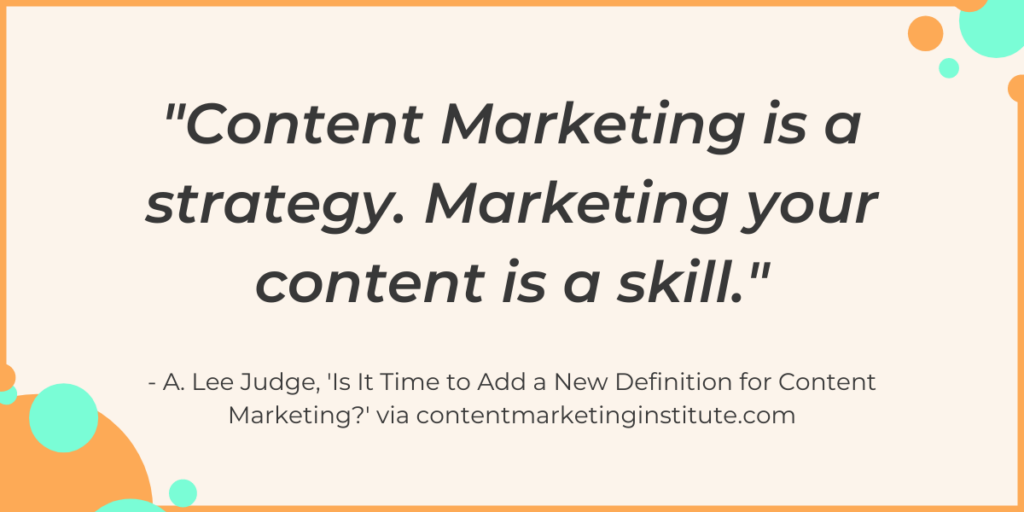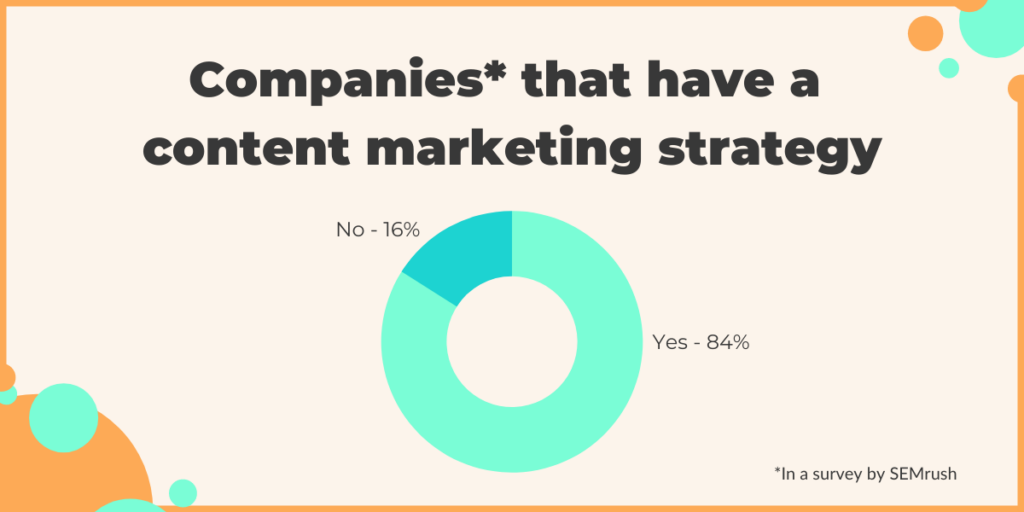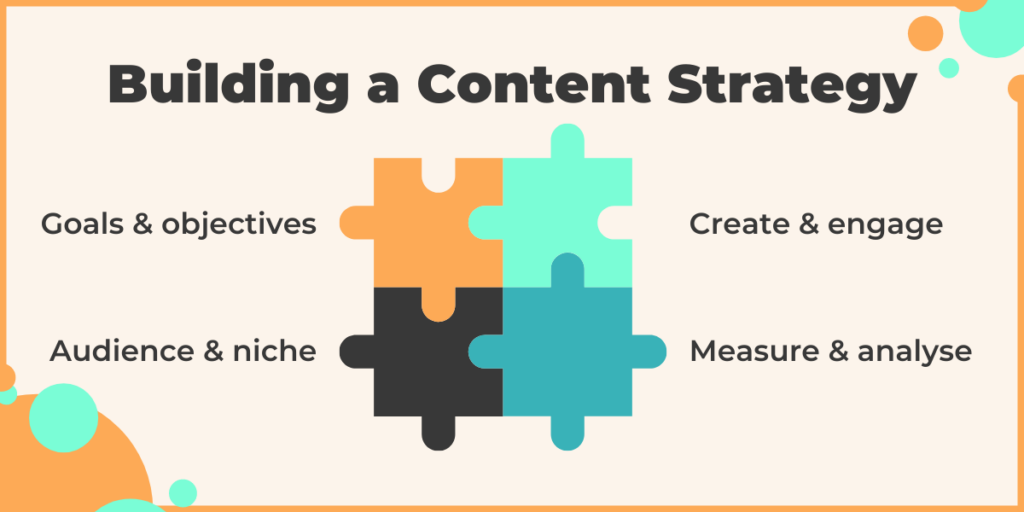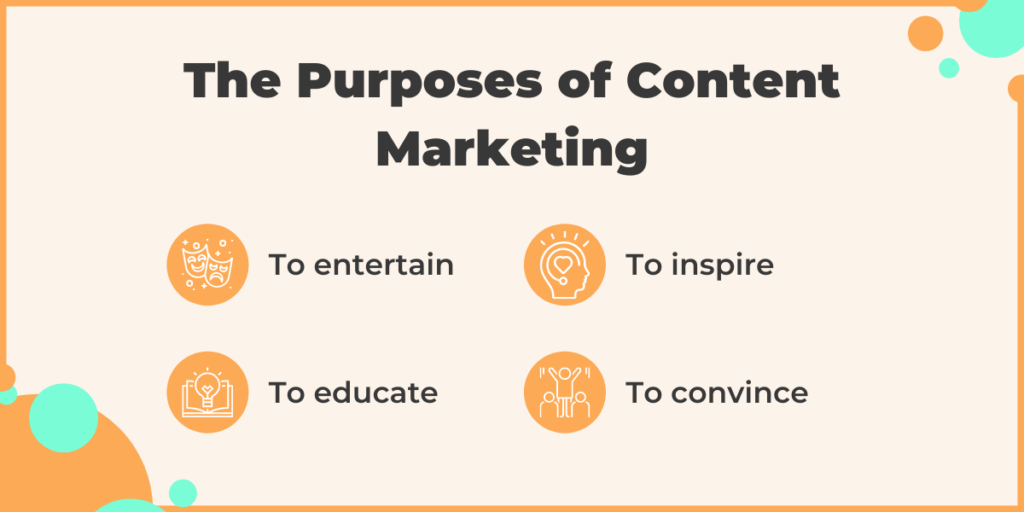Content marketing is a great asset to any business that wants to utilise all the benefits digital marketing can have for your brand. But where should you start? And what makes a great content strategy?
Here’s the Giraffe Social guide on creating a content marketing strategy that will help you achieve your business’s goals and objectives.
What is content marketing?
Content marketing, like email and social media marketing, is a branch that stems from the digital marketing tree, which has grown out of technology combined with traditional forms of marketing.
According to the Content Marketing Institute, the form of marketing is “a strategic marketing approach focused on creating and distributing valuable, relevant, and consistent content to attract and retain a clearly-defined audience — and, ultimately, to drive profitable customer action.”

But one can argue that content marketing isn’t just a strategic marketing approach, at least not anymore. Since its conception, content marketing has evolved to spawn “new job titles, careers, departments, and even new types of businesses;” it is now a “full-on skill set.” A. Lee Judge said it best with “content marketing is a strategy. Marketing your content is a skill.”
The History of Content Marketing
Amazingly, the earliest form of content marketing started in 1895! Content marketing started as helpful magazines, which opened a new channel of communication between brands and consumers.
Eventually, more and more brands took on this form of content marketing, with companies supplying their customers with guides and magazines. For example, The Michelin Guide started up in the 20th century as “a free travel guide to grow the demand for cars.” It has since evolved into the Michelin Guide we know today awarding Michelin Stars to restaurants all over the world.
As technology has evolved, so has content marketing – enter the second era. This epoch saw blogs, eBooks, articles, and reports come to life in digital form. Soon, podcasts, videos, blogs, and webinars expand the content marketing branch, and the area just keeps growing.
Nowadays, content marketing is more than just a helpful mag, but it does still borrow some elements from its earliest forms, such as educational value and engaging formats. In 2020, SEMrush reported that 84% of surveyed companies have a content marketing strategy, signifying the importance of content marketing for businesses’ digital marketing efforts.

The Different Types of Content Marketing
There are lots of different types of content marketing that can help you grow your business. Did you know that “84% of people expect brands to create content that provides solutions, experiences, entertainment, and events?” Marketing Solved identifies webinars, podcasts, blogging, email marketing, social media posts, infographics, quizzes and surveys, live streaming, reviews, e-books, guides and so on, all as aspects of content marketing. It’s a big part of digital marketing that takes a lot of time, effort, and money to fulfil.
Blog posts can be categorised in terms of their purpose, content, and value. The most popular choice for a blog post is the evergreen, designed and created to stand the tests of time; so, in six months, the article won’t be outdated or irrelevant (or minor parts can be edited to make sense in modern times). Evergreen articles can come in many different formats, such as how-to guides, lists, checklists, guest blogs, and so much more.
Evergreen content is shareable and can help you get backlinks to your website. They help establish your brand as a thought leader in your industry while also helping you rank in search engines. Evergreen content articles not only help your business but provide great information for your audience and readers. This type of content aims to entertain, intrigue, educate, interest, and inform. Evergreen articles should be high up in your content marketing strategy.
Alternatively, you can opt for a news article, which is more time-sensitive than the evergreen. This kind of article can be useful to express news about your company and your team. For example, you could write a monthly industry news roundup to keep your blog readers informed on the latest news. You could also use news-type articles to bring behind-the-scenes content – such as interviewing a new member of your team – to your audience and show your human side. Your audience can see what you’re doing and learn more about your brand. This helps gain their trust, which may well result in a follow or a sale. However, due to time sensitivity, news type articles will not last forever.
The Benefits of Content Marketing
Content marketing is one of the most lucrative branches of digital marketing because of the benefits it can provide to your brand, such as creating legitimacy and building trust. Other advantages include increased conversion potential, more referral and social traffic, improved brand reputation and when done right, can make you appear higher in search engines.
Content marketing can help give potential customers or clients the information they need to make a purchase or establish yourself as a trustworthy brand to buy from or work with. It’s also different from social media marketing and email marketing – but it can be tied into both of those avenues for cyclical exposure – and gives you an extra edge over your competitors. One-third of all web pages that exist online are blogs, “websites with a blog have tend to have 434% more indexed pages” than sites without (which helps your SEO), and “companies who blog receive 97% more links to their website.”
The Content Marketing Institute identify three benefits of content marketing. These are: “increased sales, cost savings, and better customers who have more loyalty.” Marketers who prioritise blogging “are 13X more likely to see positive marketing ROI,” partially due to the cost-effectiveness of running a blog. Running a blog only comes with a few costs, such as hosting your website – which you do anyway – and paying staff to write content. You may also want to include paid search engine marketing as part of your blogging efforts, but you don’t have to.
Building a Content Strategy

Choose a Goal (or Multiple)
When creating a content strategy, there is a lot to consider. Firstly, you must define your goals – what do you want to achieve from your content marketing? Is it sales, conversions, awareness, engagement, or something else? Choosing KPIs and goals is an integral piece of your content marketing puzzle, so you should be tying your business goals into your content marketing plan. For example, if you want to maximise conversions, you need to plan your content around your desired calls-to-action and conversion types; conversions can be video views, file downloads, submitting a lead form, and many other website events.
You may also have multiple goals and need to create a strategy that involves different types and purposes of content. Just like on social media, it’s recommended that your content marketing efforts are formed of diverse content rather than the same types of articles every month.
Research your audience
Before you start creating your content strategy, you need to know your audience. This means research – and a lot of it! Decide who you want to attract, figure out how to attract them with their favourite types of content, then build your strategy around your audience. For example, if you’re a vegan café, you’re going to want to market to a specific group of individuals – for instance, 18-35-year-olds of any gender in your county who follow a plant-based diet and/or a vegan lifestyle. This will reflect in your content marketing and blog articles as you will write with this audience in mind, from the language you use to the images you create to break up blog text. If you don’t have an audience in mind, your content will be too general and not draw anyone in.
Remember to look at your competitors’ audiences and other companies in your industry’s followers too. This can help provide you with a basis for who you’re looking to attract. Also, if you’re active on social media, you’ll want to acknowledge and utilise your existing social media audience in your content marketing if you’re planning to share your blog content on your social channels.
Find your niche
Use your research as inspiration and a jumping-off point for your own content. If you want to be found and heard amongst the crowd, you need to find your niche and focus on it. Search engines will list thousands of results for the topics you wish to write about. Neil Patel advises, “to avoid having your content lost in that pack, create content that stands out, is unique, has a distinct voice, and, most important, offers genuine value to readers.” If your content is not on the first few pages of a search engine result, then it’ll get lost amongst the other content writers trying to intrigue and sell.
Work out what you want to post
With so many aspects of content marketing, you may be struggling with what you want to post – blogs, case studies, eBooks, guides? There’s a lot of different types of content you may want to work on. It all depends on the amount of time and resources you have available. For example, for content such as videos, infographics, and eBooks, you may have to hire a specialist in-house or externally to create these types of content. Guides will take up a lot more time than a blog article, too, due to extensive research and fact-checking.
You need to start by identifying what types of content will be of the most value to your audience and go from there. Perhaps start with writing blog articles and branch out into other types of content once you’ve established a catalogue of useful articles on your blog.
Brainstorm your ideas
Devise as many ideas as you can before you start blogging or writing content types, so you have at least six months under your belt. This means you’ll be consistently sharing good, high-quality content, not rushing to get something out at the end of the month because you haven’t posted yet. Add campaigns to your strategy whenever you can and plan around key dates, holidays, national days, and seasonality, and big industry events.
Remember to measure and analyse
Content marketing, like the other branches of digital marketing, can be a series of trial and error. There’s a (small) possibility your first content marketing campaign could be a huge success, but most likely you will need to test, tweak, and test again to get it right. Even the ‘right’ formula will need adjusting at some point – the digital marketing world moves fast.
You need to test and experiment to find out what works best for your audience and brand. This is why you need to remember to be measuring and analysing all the work you’re carrying out. For example, check how many social shares your article gets, and how long users are staying on the blog pages.
Listen to your readers and audience
Also, when an article is shared on your social media platforms, don’t forget to look at the engagement and reach metrics. If your audience is speaking (or not speaking), listen. If they aren’t interacting with your content – that’s a bad sign which could signal the need for change in your content. You can then use all this information to work out what you should be doing more or less of in the future.
Include engaging, relevant images
Blogs without pictures are simply walls of text, which many readers will find dull and off-putting. In a world where we value visual content, visual aids to accompany blogs are crucial. In BuzzSumo’s analysis of over 1m articles, they found that “articles with an image once every 75-100 words received double the social media shares as articles with fewer images.” An interesting study also found that “When people hear information, they’re likely to remember only 10% of that information three days later. However, if a relevant image is paired with that same information, people retained 65% of the information three days later.” This contributes to the notion that relevant blog images are key in engaging your audience and sticking in their minds.
Get ready for social media
You need to get your content ready for the next big step: social media distribution. Before you start sharing, think about these three factors:
- Get serious about your headlines.
- Put thought and research into your graphics.
- Get your employees to share your content marketing efforts on their social media profiles.
You’ll also need to decide what platforms you’re going to share your articles on – Facebook, Twitter, Instagram, LinkedIn, all of the above? Each post will have to be optimised for each social media channel, and not sent all at the same time – stagger your sharing so posts go out on different days on different platforms. For example, Twitter allows fewer characters (280) than the rest of the platforms, so the post will have to be cut down with hashtags added in where appropriate. Whereas on Facebook, hashtags aren’t as much of a focus, but the content copy can be longer and allow you to fit in your relevant long-tail keywords. On Instagram, URLs do not work in captions, so you’ll have to direct users to your bio link; consider utilising a “link in bio” multi-link tool such as Linktree or Lnk.Bio.
You may also be writing for slightly different audiences between platforms, so make sure the right content gets posted to the right platforms. For example, B2B articles will be far more beneficial when shared on LinkedIn. Ultimately, though, it depends on your specific market.
Then you’ll have to decide what time to post. You can do this by simply checking your social media analytics and seeing when your audience is online and most active. Some third-party social media scheduling tools also have algorithms that can determine for you the best time to post on particular days.
The Content Marketing Matrix
According to Digital Marketing Magazine, a Content Marketing Matrix is “a framework from which a content marketer can consider and plan how best to be there for their target audience with the right content at the right time and in the right place.” It’s a content mapping tool, that lets you think about what to create for a future content marketing strategy. It’s your guide as you create a content strategy.
You can find templates online for content marketing matrixes, but you must figure out what KPIs you use or want to track, so you can see the results of the effort you’re putting into your content marketing. You can then use the grid to plot the different content formats and figure out what works best and why. Thus, you can edit the grid when you try out new things and see what changes. You can read more about content marketing matrixes in our article here.
The Purposes of Content Marketing
Like every branch of digital marketing, content marketing has its purposes; it gives you something to aim for as a brand. Your content marketing efforts should contain content with a variety of purposes, such as:
- To entertain: Entertaining content is engaging and creates interest and awareness.
- To inspire: Inspiring content tugs on the emotional heartstrings and leads to more conversions when used later in the buying process. This type of content must be relatable and make the reader feel something.
- To educate: Educational content helps your customers learn something new either about an industry topic or your products and services. This type of content helps establish your business as a thought leader and centres you as a trusted source. They require a lot of research and detail to provide educational value.
- To convince: Convincing content works in the last stage of the buyer’s journey, the decision stage. It’s important to know what your audience wants at this point and create content that’s accessible and influential.
You can then incorporate these purposes into your content marketing matrix.

Content for B2C and B2B
Business-to-customer (B2C) content and business-to-business (B2B) content varies much like it does in social media marketing. You’re targeting a different kind of audience, but both require you to be knowledgeable in your field.
Content marketing has specific benefits for both business models. For example, “B2B companies with a blog receive more leads than those that don’t” and “a B2B blog has tremendous SEO benefits and organic search attracts high-quality leads’. Content should be rational, well-research, and expertly delivered to succeed in the B2B sphere, offering great value and benefit to the reader. On professional network LinkedIn, B2B content reigns supreme, with an average post receiving 25.7 shares compared to a mere 9.8 for B2C content.
On the other hand, B2C content can help encourage customers to trust and engage with your brand. Therefore, “B2C content should be inspirational, emotional, and primarily entertaining.” Facebook comes out on top for distributing content of this style, so it’s a good idea to craft content with Facebook shares in mind. Meanwhile, Instagram is great for more visual brands with products to showcase and drive sales.
Whether B2C or B2B, your content marketing strategy will seriously benefit from a careful and considered approach to distribution on your social networks. Invest in it, and you should see the results in time.
Historical Optimisation and the Repurposing of Content
Historical optimisation is repurposing your old content and updating it for present times. For blogs that have been active for years, there are bound to be articles that have become outdated – even evergreen articles will need touching up due to the fast-paced nature of the online world. It has to be up-to-date and emit anything that is now irrelevant. Go for posts on your blog that were published over a year ago, or 6+ months ago if they’re in dire need of updates due to big industry changes. Historical optimisation can help the article generate “even more traffic and conversions than it already does.’
The idea behind historical optimisation is that, alongside creating new blog articles, you should focus some attention on the content that already works by optimising it for relevancy. Content marketers get so caught up in producing new articles that older ones are left to collect dust when they could be updated and thriving again.
HubSpot found that as a result of their continuous historical optimisation, they’ve been able to add value from past published content. They “more than doubled the number of monthly leads generated by the old posts” and “increased the number of monthly organic search views of old posts they’ve optimised by an average of 106%.”
You can also repurpose your blog content in other ways. Consider setting up a task each month to go through your content marketing efforts and work them into meaningful, repurposed posts. You can:
- Repurpose snippets and quotes as social media posts,
- Create feature graphics,
- Create an infographic,
- Do a live webinar/Q&A on the subject,
- Create video tutorials or an ongoing podcast on your weekly content,
- Amalgamate content into whitepapers and how-to guides.
Every piece of content you produce can have an impact on multiple social networks; it’s all about repurposing content for each network’s format, audience, and purpose. This is one of the simplest ways to increase your campaigns’ capacities for engagement and success.
How Giraffe use Content Marketing
At Giraffe Social Media, we use content marketing to educate and interest our audience. We write a multitude of blog articles per month on a range of different subjects that we’ve planned in advance.
A simple mind-mapping activity between you and your team can help you come up with lots of different ideas for your blogs. Our articles are primarily evergreen, with a monthly news article to keep everyone up to date with what’s happening in the social media industry, and a monthly cornerstone piece (just like this one!) to serve as the hub for a big topic (in this case, content marketing strategy).
We aim for our blog to be a web of useful information for several broad topics and their subtopics. Organised into categories, our blog posts tackle everything social media-related, from comprehensive guides to infographics to social media case studies.
The Future of Content Marketing
The future of content marketing is a bright one and it’ll be interesting to see how it will evolve and change over the next few years. Technological advancements, such as virtual reality (VR), augmented reality (AR), and artificial intelligence (AI), have already made waves in the digital marketing world, and we’re sure that it’s only just getting started.
Content marketing is already well intertwined with social media, and vice versa, and we expect this to continue in the future. The two need to complement each other for brands to have a thriving social media presence and a popular, valuable blog.
As social media specialists, we help businesses all around the world reach their digital marketing objectives, including their content marketing goals. If your business needs help with content marketing, please get in touch today.
Editor’s Note: This article was originally published in November 2019 and has been updated for accuracy and relevance in July 2023.






